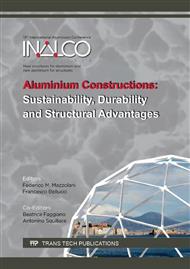[1]
Official high-res car pictures published with the permission of the owners, www. mad4wheels. com, 19. 09. (2013).
Google Scholar
[2]
Takuda H., Fujimoto H., Hatta N.: Formabilities of steel/aluminium alloy laminated composite sheets, Journal of Materials Science Vol 33, pp.91-97, Chapman & Hall, (1998).
Google Scholar
[3]
Sierraa G., Peyre P., Deschaux-Beaume F., Stuart D., Fras G.: Steel to aluminium key-hole laser welding, Materials Science and Engineering A 447, p.197–208, Elsevier Science Ltd, (2007).
DOI: 10.1016/j.msea.2006.10.106
Google Scholar
[4]
Taylor, G. T.: The design by finite elements of riveted aluminium/steel composite structures, Proceedings of the 7th World Congress on Finite Element Methods, Monte Carlo, 1993, p.330–335.
Google Scholar
[5]
Macdonald M.: Bending of a thin-walled combined section beam, MSc thesis, University of Strathclyde, Glasgow, (1993).
Google Scholar
[6]
Taylor G. T., Macdonald M., Rhodes J.: The Design Analysis of Light Structures with Combined Aluminium/Steel Sections, Elsevier Science Ltd., Thin-Walled Structures Vol. 30, Nos 1–4, 1998, p.111–133.
DOI: 10.1016/s0263-8231(97)00015-3
Google Scholar
[7]
Kissell R., Ferry R.: Aluminum Structures - A Guide to Their Specifications and Design, Second Edition, John Wiley & Sons, Inc., (2002).
Google Scholar
[8]
Mazzolani F.: Aluminium Alloy Structures (2nd edition), E &FN SPON, London, (1995).
Google Scholar
[9]
Gligic B.: Stability of structural elements made from aluminium alloys, MSc thesis, Faculty of civil engineering, University of Belgrade, (1993).
Google Scholar
[10]
Skejic, D., Boko, I., Toric, N.: Aluminium as a material for modern structures, GRAĐEVINAR 67 (2015) 11, pp.1075-1085, doi: 10. 14256/JCE. 1395. (2015).
Google Scholar
[11]
EN 1999-1-1: 2007+A1 - Eurocode 9: Design of aluminium structures - Part 1-1: General structural rules.
Google Scholar
[12]
ENV 1999-1-1: 1998 - Eurocode 9: Design of aluminium structures - Part 1-1: General rules - General rules and rules for buildings.
DOI: 10.3403/02163035
Google Scholar
[13]
DDV 1999-1-1: 2000 - Eurocode 9: Design of aluminium structures - Part 1-1: General rules - General rules and rules for buildings.
DOI: 10.3403/02163035
Google Scholar
[14]
EN 1993-1-1: 2005 - Eurocode 3: Design of steel structures - Part 1-1: General rules and rules for buildings.
Google Scholar


